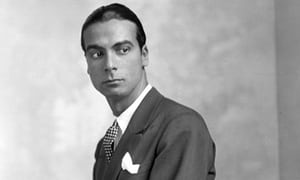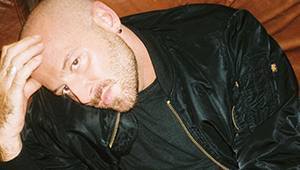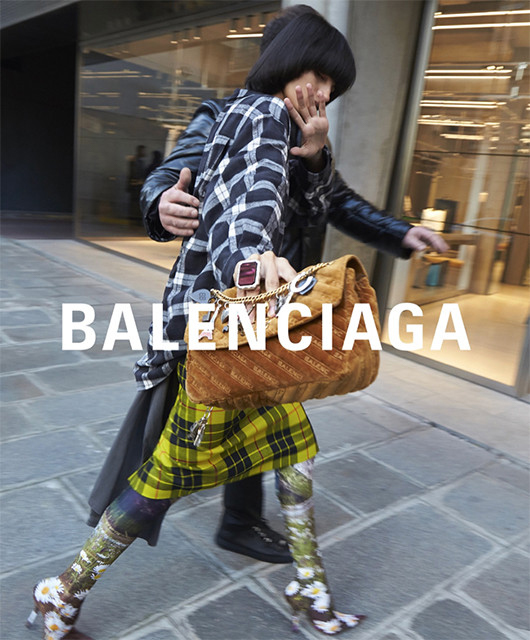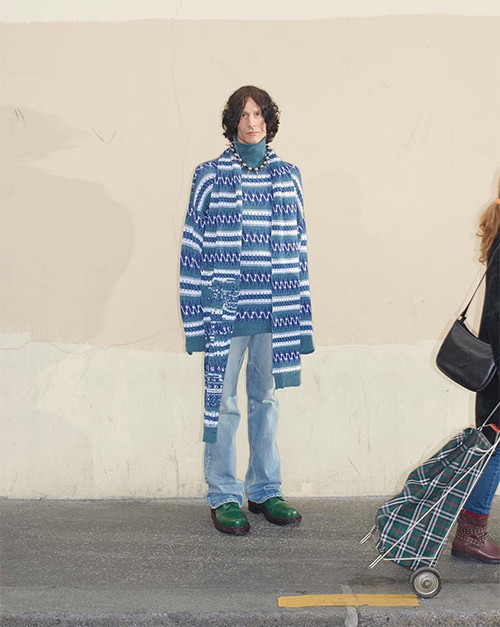"HISTORY"

Cristóbal Balenciaga, founder of fashion house Balenciaga, wanted women of strong character to wear his designs. So devoted were his clients that one in particular, Countess Mona Bismarck, mourned the designer's retirement in 1968, by cloistering herself in her room for three days. This brand is known for setting trends rather than following them: Cristóbal pioneered the baby doll, tunic and waistless 'sack' dress while later Nicolas Ghesquière launched the Lariat handbag in 2001. Model Kate Moss was the first to carry it,ensuring that waiting lists for this 'IT' bag were off the Richter scale.
Christian Dior was in awe of rival Cristóbal Balenciaga and once said "Haute couture is like an orchestra, whose conductor is Balenciaga,” he once said. “We other couturiers are the musicians and we follow the directions he gives.”
Balenciaga began when Cristóbal Balenciaga opened his first boutique in San Sebastián, Spain in 1918, which expanded to include branches in Madrid and Barcelona. When the Spanish Civil War forced the boutiques to close, he moved to Paris. Here, his success was almost immediate with customers travelling across Europe risking their safety, during a wartime period, to see his designs. However, it was not until after the war that his inventiveness as a designer was fully realised.
The lines of his designs were sleek and linear, moving away from Christian Dior’s ‘New Look’ which had championed the hourglass shape. The tunic shift, cocoon coat and high-waisted baby doll dress are just some of the designs he created after the war. His attention to the female waist and the different looks he used to complement it attracted huge attention and is “considered to be his most important contribution to the world of fashion: a new silhouette for women." After a hugely successful career, Cristóbal Balenciaga closed his fashion house in 1968 and died in 1972. The house lay dormant until 1986.
That year, Jacques Bogart S.A. acquired the rights to Balenciaga, and opened a new ready-to-wear line, Le Dix. The first collection was designed by Michel Goma in October 1987, who remained at the house for the next five years amid mixed reviews. He was replaced in 1992 with Dutch designer Josephus Thimister who can be credited with beginning the restoration of Balenciaga to an elite, high-fashion status. However, neither of these designers achieved the same success as Cristóbal Balenciaga. During Thimister's term, Nicolas Ghesquière would join as a license designer, and eventually was promoted to head designer in 1997. Ghesquière, like Cristóbal, designed clothes for 'strong' women and his work attracted the attention of Vogue editor Anna Wintour. Kate Moss, Chloë Sevigny, and Charlotte Gainsbourg, individual and unique trendsetters, became ardent fans as well as muses.
Taking inspiration from Balenciaga's early work, Ghesquière told Vogue in 2006 that he was inspired by “all the extreme part of Balenciaga’s work: the overdecorated pieces, the organic pieces, and the futuristic, absolutely abstract pieces.” Cargo pants, Lego-like heels and Lariat handbags were just some of the trends that he launched. On November 5, 2012, Balenciaga announced that it was parting ways with creative director Nicolas Ghesquière, and Alexander Wang took over as creative director. Wang showed his first collection in Feburary 2013, he honoured Cristóbal Balenciaga's legacy, showing a beautiful collection that honoured the founder's fashion legacy. "I just did what was coming from my heart," he explained to Elle magazine. "You don't always have to do everything at once." He added, "Women still want something that feels liberating, that feels new, that feels inspiring. Women want to be seduced."
Alexander Wang has brought a new dimension to the revered Balenciaga name: youthful, edgy and wearable yet still eminently stylish. Wang left the brand in 2015.
Following his replacement with Vetements founder Demna Gvasalia, the brand came into a new level of success. Hypebeasts everywhere flocked to the ultimate dad shoe: the tripple s trainer, as well as the Balenciaga runner before it. For it's FW17 campaign, Demna pioneered a series of designs based on the campaign materials of Bernie Sanders. This solidified Balenciaga's status as a brand both known for quality and relevance.
Some parts from her.ie. Others are original.
"BRAND"

“I think of uniforms quite a bit,” said Demna, 35, referring back to a childhood spent in the Soviet Union. "I love social uniforms – what the message means for somebody. I used to wear security T-shirts and people would think I am a security guy. It's the connotation of clothes. Without people knowing you, it brings a message. I think it comes from the lack of diversity in a period of my youth. Everybody dressed the same because there was no choice."
The impact of plain and simple clothes, with a powerful, underlying message, turned Vetements, meaning “clothes” in French, from an unknown fashion collective showing in a Paris gay bar or a downtown Chinese restaurant, into a brand that seemed to define the social upheavals across the world. And now, with Demna as Artistic Director of Balenciaga, the essence of exclusive haute couture, his work expresses a dramatic change in the character of high fashion.
The designer himself, with a background in economics and the experience of working at Louis Vuitton, first with Marc Jacobs and then Nicolas Ghesquière, insists that the choice of venues for a Vetements show is not deliberately controversial. (Although controversy was inevitable when he presented clothes with an aggressive attitude in a church and followed that up with a presentation in the highly commercial retail environment of French fashion department store Galeries Lafayette.)
''It's not against the system – I feel that ‘anti’ is almost too much of a statement for what we did and how we function,” says Demna, who turned a basic hoodie into a worldwide object of desire, with the help of eager customer Kanye West (What better endorsement than Kanye’s playful tweet, “I’m going to steal Demna from Balenciaga”?).
“Whether it is Vetements or Balenciaga, it's not against anything – it's really just about finding the better way to survive today and doing things that make sense to me," says the designer, claiming that his venue choices were about “the cheapest place I could find”. His first Balenciaga show, held in an empty former television studio, was also far away from the gilt chairs and velvet cushions of haute couture.
Demna and Guram were born in Georgia, in the north-western area of Abkhazia, into an extended family that the designer describes as “almost a gypsy clan” and “like in southern Italy where cousins are called brothers”.
"But I always wanted to get out of all that – I was definitely an outsider,' said Demna, whose childhood was ruptured at age 12, when a civil war forced the family to leave home with “nothing but photo albums” and then to lead a peripatetic life.
"Six!" announced Demna when I asked how many languages he spoke. ''I speak Russian, Georgian, English, French, Italian, German – and a little bit of Flemish." The latter came from his three years at fashion college in Antwerp under legendary teacher Linda Loppa.
"She really changed my view on fashion because she had this very pragmatic approach of a buyer, but always with an immense knowledge of fashion,” Demna said. "She would say: do you know someone who would like to wear that? If you don't, then you have to change it."
After three years in Antwerp, when he had to choose “between buying three metres of fabric or a can of something to eat", Demna graduated in 2006 and joined Margiela – shortly before the designer left the house that bore his name. "For me it was like an MA in fashion being there," Demna explained. "Understanding the concept and how you need to destroy something to create the new."
When Demna came to Balenciaga, he took the same approach, wanting "to discover the method of Cristóbal's work, his approach, how he saw a woman, his mentality behind his creative process". On the runway, the first women's show presented a sporty, modern version of Balenciaga’s codes: for instance, turning the famous 1950s couture coats that stood out like sculptures around the body into giant bomber jackets.
I found it hard to imagine Demna, who admits to "having a silence phobia and always needing to have a very loud sound when I work", in the atelier of the whisper-quiet Cristóbal. But he found the house, which is part of the Kering luxury group, to be "really structured with a very organised team. It makes life very easy. Even in two and a half days I can do an enormous amount of work”.
Compare that experience to Vetements itself, with its loose group of fashion enthusiasts, including muse and stylist Lotta Volkova, making bad taste look good, and, of course, Demna’s brother Guram, with his four degrees in law and business.
"The blood link is the biggest challenge – we can't fire each other so it stays in the family,' says Demna. "My brother is important because he really manages everything, while I do the creative part. Everything else is his strategic thinking about distribution and sales. He has some novel ideas about this, so it is all good exchange."
I asked Guram about his business policy and received a deep and powerful analysis of how Vetements is playing with the supply and demand curve in a rare strategy to “produce one less piece than is needed so it is sold out – so people know that if they don't buy it now, they could lose the opportunity”.
With Demna, I go back to the Georgian family tree and a childhood in the Soviet Union where "toothpaste wasn't called ‘Colgate’ – there was only one"; and where his half-French Jewish grandmother in her lace maxi skirts and jewellery painted with nail varnish was the lone figure daring to be different.
"The lack of diversity defined this drive and hunger for putting many things together – it became almost a cultural bulimia in terms of music, art and the flow of information after the Soviet Union collapsed,'' Demna said.
"By diversity, I mean in terms of creative approach," he continued. "It's a mix and match of many things. In my adolescent years, until 1993, we were living in the Soviet Union; we had no information. The first ever fashion magazine I saw was Vogue."
I asked Demna how his parents – who insisted he study business and economics after he left school – viewed his life in fashion. “Not until I went to Balenciaga,” he said. "Then they finally accepted me as a fashion designer. But I have very much a business approach. I don't see it as a dreamy world of fantasy but as a business and concept. It's pragmatism."
Taken from an article in Vogue Japan





